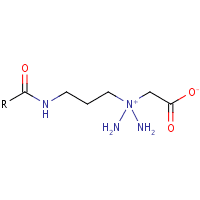Formula C19H38N2O3 | ||
 | ||
Cocamidopropyl betaine (CAPB) is a mixture of closely related organic compounds derived from coconut oil and dimethylaminopropylamine. CAPB is available as a viscous pale yellow solution and it is used as a surfactant in personal care products. The name reflects that the major part of the molecule, the lauric acid group, is derived from coconut oil. Cocamidopropyl betaine to a significant degree has replaced cocamide DEA.
Contents
Cocamidopropyl betaine
Production
Despite the name cocamidopropyl betaine is not synthesized from betaine. Instead, it is synthesized beginning with the production of an amide by reacting dimethylaminopropylamine with fatty acids from coconut oil, mainly lauric acid) (Step 1). The amide is then reacted with chloroacetic acid to form the cocamidopropyl betaine (Step 2).
CH3(CH2)10C(O)OH + H2NCH2CH2CH2N(CH3)2 → CH3(CH2)10C(O)N(H)CH2CH2CH2N(CH3)2 (Step 1)CH3(CH2)10C(O)N(H)CH2CH2CH2N(CH3)2 + ClCH2CO2H + NaOH → CH3(CH2)10C(O)N(H)CH2CH2CH2N+(CH3)2CH2CO2− + NaCl + H2O (Step 2)Chemistry
CAPB is a fatty acid amide containing a long hydrocarbon chain at one end and a polar group at the other. This allows CAPB to act as a surfactant and as a detergent. It is a zwitterion, consisting of both a quaternary ammonium cation and a carboxylate.
Specifications and properties
Cocamidopropyl betaine is used as a foam booster in shampoos. It is a medium strength surfactant also used in bath products like hand soaps. It is also used in cosmetics as an emulsifying agent and thickener, and to reduce irritation purely ionic surfactants would cause. It also serves as an antistatic agent in hair conditioners, which most often does not irritate skin or mucous membranes. However, some studies indicate it is an allergen. It also has antiseptic properties, making it suitable for personal sanitary products. It is compatible with other cationic, anionic, and nonionic surfactants.
CAPB is obtained as an aqueous solution in concentrations of about 30%.
Typical impurities of leading manufacturers today:
The impurities AA and DMAPA are most critical, as they have been shown to be responsible for skin sensitation reactions. These by-products can be avoided by a moderate excess chloroacetate and the exact adjustment of pH value during betainization reaction accompanied by regular analytical control.
Safety
CAPB has been claimed to cause allergic reactions in some users, but a controlled pilot study has found that these cases may represent irritant reactions rather than true allergic reactions. Furthermore, results of human studies have shown that CAPB has a low sensitizing potential if impurities with amidoamine (AA) and dimethylaminopropylamine (DMAPA) are low and tightly controlled. Other studies have concluded that most apparent allergic reactions to CAPB are more likely due to amidoamine. Cocamidopropyl betaine was voted 2004 Allergen of the Year by the American Contact Dermatitis Society.
